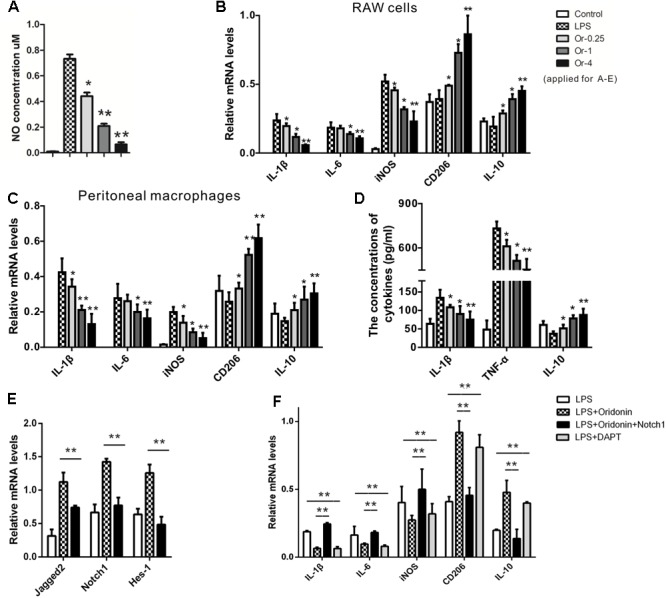FIGURE 1.

Effects of Oridonin on phenotypic switch of macrophage polarization and Notch pathway in vitro. In vitro cultured macrophage cells were stimulated by LPS, transfected with Notch1 or vehicle plasmid, and treated with Oridonin or DAPT. NO concentrations, proportions of PCR products relative to the house keeping β-actin and cytokine concentrations are presented as bar graphs. (A) Upon the induction of LPS, NO production in RAW cell culture was increased compared to the control. Further, NO concentrations were significantly reduced by Oridonin treatment, in a clear dose-dependent pattern. (B,C) In both RAW cells and primary macrophages, the RNA levels of IL-1β, IL-6 and iNOS, the markers of inflammatory macrophages, were significantly decreased by Oridonin treatment. On the contrary, CD206 and IL-10 mRNA levels, the markers of anti-inflammatory phenotype, were significantly increased. All these results also presented clear dose-dependent patterns. (D) ELISA assays showed that the concentrations of IL-1β and TNF-α were reduced by Oridonin treatment and the level of IL-10 was increased in primary macrophages, in a dose-dependent pattern as well. (E) mRNA levels of Notch pathway involved molecules Jagged-2, Notch1 and Hes-1 were remarkably inhibited by Oridonin treatment in RAW cells. (F) In RAW cells, increased mRNA levels of IL-1β, IL-6 and iNOS were induced by LPS. Their levels were decreased by Oridonin or DAPT, whereas the levels of CD206 and IL-10 were reversed. But the Oridonin’s effects were abolished by the transient transfection of Notch1. Cells from the other groups were all transiently transfected with vehicle plasmid. (Or-0.25, -1, -4 = Oridonin concentrations of 0.25, 1, and 4 μM. ∗p < 0.05, ∗∗p < 0.01 compared to their respective controls). Graphs show mean ± SEM of triplicate wells and represent data from three independent experiments.
